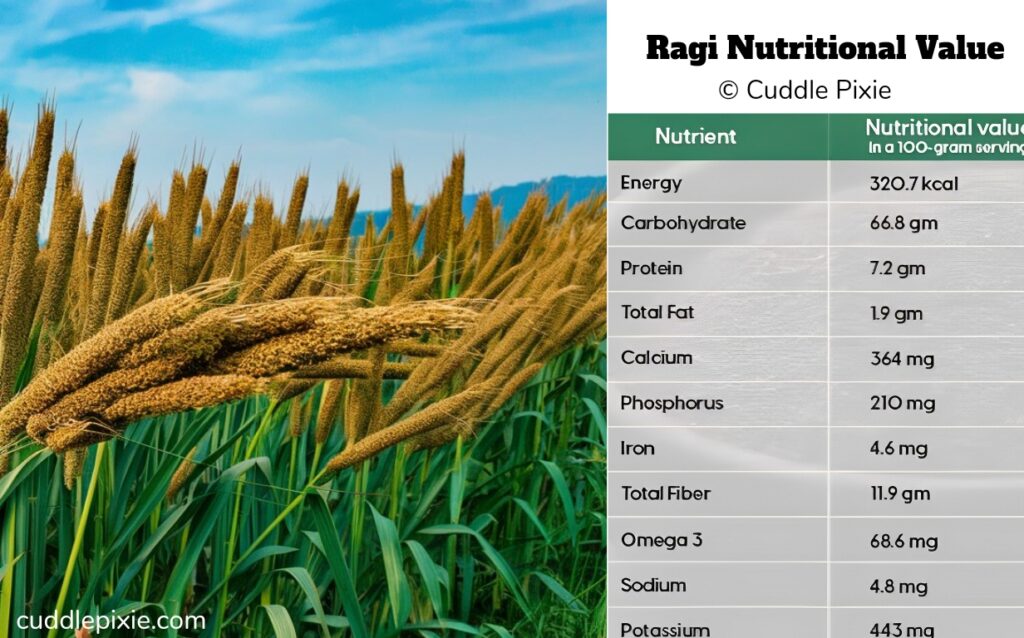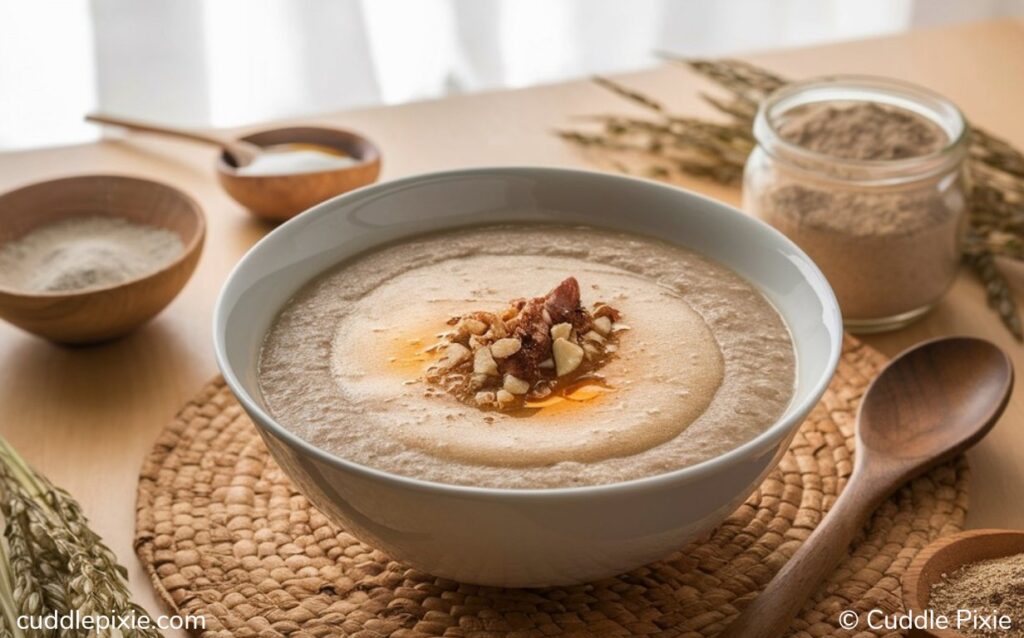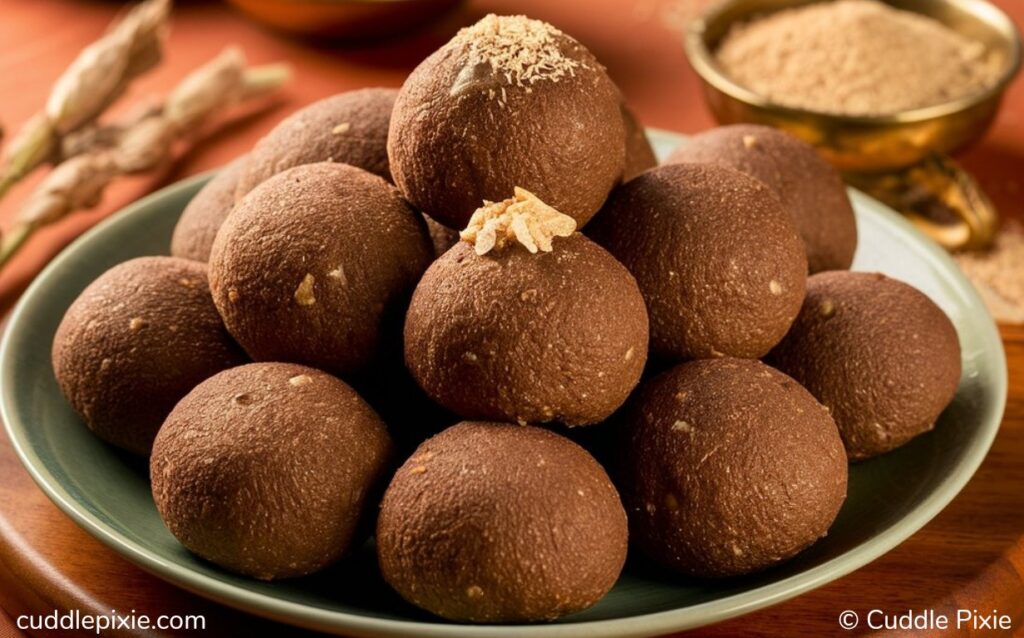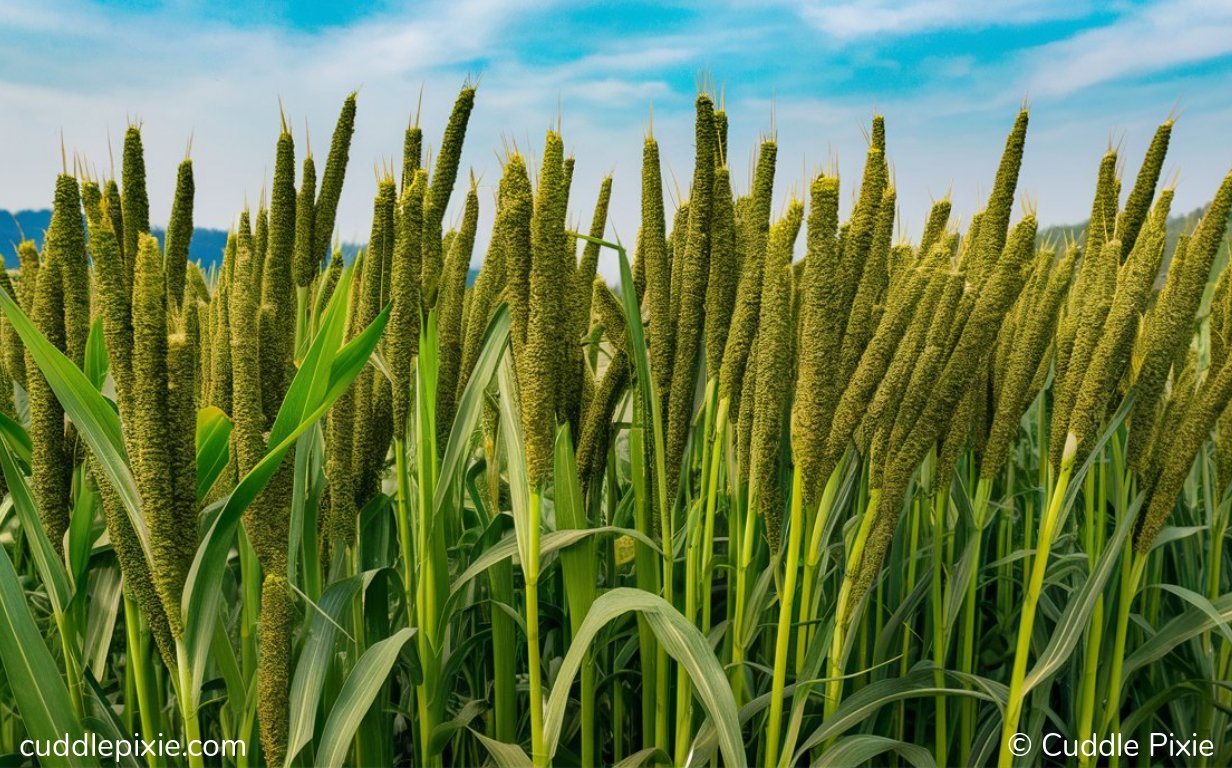As a parent, ensuring your baby’s diet is both nutritious and delicious is a top priority. In recent years, ragi (also known as finger millet) has gained popularity as a superfood for babies, especially in India and other parts of Asia. But what exactly makes ragi so beneficial for babies, and how can it be incorporated into their diet? This comprehensive guide will walk you through the myriad health benefits of ragi, particularly for infants, while also shedding light on its use during pregnancy and beyond.
In This Article
What is Ragi?
Ragi, scientifically known as Eleusine coracana, is a type of millet that has been cultivated for thousands of years, primarily in Africa and Asia. It’s often hailed as a superfood due to its dense nutrient profile. Unlike many other grains, ragi is naturally gluten-free, making it an excellent choice for those with gluten sensitivities. It’s rich in essential nutrients like calcium, iron, fiber, and protein, all of which are crucial for the growth and development of babies.
Nutritional Profile of Ragi: A Powerhouse of Nutrients
Ragi is incredibly nutrient-dense, offering a variety of vitamins and minerals that are essential for a baby’s development. Here’s a breakdown of the key nutrients found in ragi:
- Calcium: Ragi is one of the richest plant sources of calcium, containing 344 mg per 100 grams. Calcium is vital for the development of strong bones and teeth, particularly in growing infants.
- Iron: Ragi is also high in iron, which is crucial for preventing anemia and supporting healthy brain development.
- Fiber: With 3.6 grams of fiber per 100 grams, ragi aids in digestion and helps prevent constipation in babies.
- Protein: Ragi provides about 7.6 grams of protein per 100 grams, which is essential for muscle development and overall growth.
- Vitamins: Ragi is rich in vitamins like B1, B2, and B3, which are crucial for energy production and overall metabolic function.
Dr. Sweta Roy, a pediatrician and child nutrition specialist, emphasizes, “The nutrient composition of ragi makes it a perfect first food for babies. Its high calcium content is particularly important for infants in their early stages of bone and tooth development.”

Health Benefits of Ragi for Babies
Introducing solid foods to a baby’s diet is a significant milestone, and choosing the right foods is crucial. Ragi is often recommended as one of the first solid foods for babies who are around six months old. Here’s why:
- Easy to Digest: Ragi is light on the stomach and easy to digest, making it an ideal food for babies who are just starting on solids.
- High in Calcium: The high calcium content supports the development of strong bones and teeth, which is particularly important as babies start to grow.
- Promotes Weight Gain: For babies who may be underweight, ragi can help promote healthy weight gain due to its high nutrient density.
Dr. Meena Muthiah, an Obstetrician & Gynecologist, suggests, “Ragi is an excellent first food for babies due to its high calcium and iron content. It’s gentle on the stomach and can be easily digested, which makes it a great option for infants just beginning to explore solid foods.”
Boosting Immunity with Ragi
One of the standout benefits of ragi is its ability to boost the immune system, which is especially important for babies as they begin to explore the world around them.
- Rich in Antioxidants: Ragi contains several antioxidants, such as phenolic acids and flavonoids, which help combat oxidative stress in the body and strengthen the immune system.
- Enhances Overall Health: The combination of essential vitamins and minerals in ragi, including iron and magnesium, contributes to overall health and supports the immune system.
According to Dr. Arvind Sharma, a pediatric immunologist, “The high antioxidant content in ragi helps in neutralizing free radicals, which is critical for building a strong immune system in infants.”
Ragi as a Natural Laxative
Babies can sometimes experience digestive issues as they transition to solid foods. Ragi’s high fiber content makes it an excellent natural laxative, helping to prevent constipation and promote healthy bowel movements.
- Promotes Healthy Digestion: The dietary fiber in ragi aids digestion and ensures smooth bowel movements, which is especially beneficial for babies.
- Prevents Constipation: By adding bulk to the stool, ragi helps prevent constipation, a common issue among infants.
Dr. Aparna Singh, a pediatric nutritionist, notes, “Ragi’s fiber content is ideal for keeping your baby’s digestive system on track. It’s a natural way to prevent constipation as they transition from milk to solid foods.”

Ragi for Bone Health and Development
As mentioned earlier, ragi is a rich source of calcium, which is crucial for bone health. For babies, adequate calcium intake is essential for the development of strong bones and teeth.
- Bone Strengthening: The high calcium content in ragi supports the growth of strong bones and teeth, ensuring that your baby develops a healthy skeletal structure.
- Teeth Development: Ragi also contributes to the healthy development of teeth, which is vital as babies begin to teethe.
Dr. Radha Krishnan, a pediatric orthopedic surgeon, explains, “The calcium in ragi is bioavailable, meaning it’s easily absorbed by the body, which is crucial for developing bones and teeth in infants.”
Ragi for Healthy Weight Gain
If your baby is on the lean side, ragi can help promote healthy weight gain. It’s packed with essential nutrients that not only nourish the body but also provide the necessary calories for growth.
- Energy-Dense: Ragi provides a good amount of energy due to its carbohydrate content, making it ideal for active, growing babies.
- Promotes Healthy Growth: The combination of proteins, vitamins, and minerals in ragi supports healthy growth and development.
Dr. Neha Agarwal, a pediatrician specializing in infant nutrition, states, “Ragi is a nutrient-rich grain that provides the energy and nutrients babies need for steady growth. It’s particularly beneficial for babies who need to gain weight.”
Supports Brain Development
Ragi is rich in iron, which is essential for cognitive development in babies. Adequate iron intake ensures proper oxygen supply to the brain, which is crucial for learning and development.
- Prevents Anemia: Iron deficiency can lead to anemia, which can impair cognitive development. Including ragi in your baby’s diet helps prevent this condition.
- Supports Cognitive Functions: Iron-rich foods like ragi ensure that your baby’s brain receives the oxygen it needs to function properly, supporting learning and cognitive development.
Dr. Shalini Nair, a pediatric psychiatrist, highlights, “Iron is vital for brain development during the early years, and ragi’s high iron content helps ensure that your baby’s cognitive functions develop optimally.”
Ragi for Healthy Skin and Hair
The health benefits of ragi extend beyond just internal health. Ragi is also known to promote healthy skin and hair due to its high vitamin and mineral content.
- Rich in Amino Acids: Ragi contains amino acids like methionine, which are essential for maintaining healthy skin and hair.
- Prevents Skin Conditions: The antioxidants in ragi help prevent skin conditions by reducing oxidative stress.
Dr. Raghavendra Rao, a dermatologist, suggests, “Including ragi in your baby’s diet can help maintain healthy skin due to its high antioxidant and amino acid content, which nourish the skin from within.”
How to Introduce Ragi to Your Baby’s Diet

The best time to introduce ragi to your baby’s diet is around six months when they begin to explore solid foods. Here’s how to do it:
- Start with Small Quantities: Begin with a small amount of ragi, such as a teaspoon mixed with water or breast milk, to test for any allergies.
- Consistency Matters: Ensure the ragi is well-cooked and has a smooth, runny consistency, similar to breast milk or formula, making it easier for your baby to swallow.
- Monitor for Allergies: Like with any new food, introduce ragi gradually and monitor your baby for any signs of allergies, such as rashes or digestive issues.
Safe Ragi Recipes for Babies
There are several ways to incorporate ragi into your baby’s diet. Here are some safe and easy-to-prepare ragi recipes:
- Ragi Porridge: The most common and easy-to-digest recipe, ragi porridge is made by cooking ragi flour with water or milk until it reaches a smooth consistency. You can sweeten it naturally with a small amount of mashed banana or apple.
- Ragi Idli: A soft, steamed dish, ragi idli is another excellent way to introduce ragi. It can be prepared by mixing ragi flour with fermented rice batter.
- Ragi Ladoo: As your baby grows older and starts consuming finger foods, ragi ladoo can be a nutritious snack. Made from ragi flour, ghee, and jaggery, it’s a healthy treat that’s easy to hold and eat.
Pro Tip: For added nutrition, consider sprouting the ragi grains before using them in recipes. Sprouting enhances the bioavailability of nutrients, particularly calcium and iron, making them easier for your baby’s body to absorb.

Ragi Flour vs. Ragi Millet: Which is Better for Babies?
Both ragi flour and ragi millet have their benefits, but which one is better for your baby? Here’s a quick comparison:
- Ragi Flour: Easier to digest, ragi flour is ideal for making porridges and other soft foods for babies. It’s also quicker to cook and can be easily mixed with other ingredients.
- Ragi Millet: Whole ragi millet retains more of its natural nutrients and is more fiber-rich, making it a healthier option. However, it requires more preparation, such as soaking and grinding, before it can be used in baby food.
For younger babies, ragi flour is often the preferred choice due to its ease of digestion. As your baby grows older and can handle more texture, whole ragi millet can be introduced for added nutritional benefits.
Common Concerns and Side Effects of Ragi
While ragi is generally safe and highly beneficial, there are some concerns to be aware of:
- Potential Allergies: Although rare, some babies may be allergic to ragi. It’s important to introduce ragi slowly and monitor for any signs of allergies.
- Overconsumption: Ragi is rich in nutrients, but like any food, it should be consumed in moderation. Overfeeding ragi can lead to excessive calcium intake, which might cause issues like hypercalcemia in rare cases.
- Phytates and Oxalates: Ragi contains naturally occurring compounds called phytates and oxalates, which can interfere with the absorption of certain minerals. Soaking or sprouting ragi before cooking can help reduce these compounds.
Dr. Ibrahim Yusuf, a pediatrician, advises, “While ragi is an excellent food for babies, it’s important to introduce it gradually and in moderation. Monitoring for any allergic reactions is crucial, especially when introducing new foods.”
Health Benefits of Ragi During Pregnancy
Ragi isn’t just beneficial for babies; it’s also highly recommended for pregnant women. Here’s why ragi should be a staple in the diet of expectant mothers:
Supports Bone Health
Pregnant women have an increased requirement for calcium to support the growing baby’s skeletal development. Ragi, being rich in calcium, helps meet this requirement.
- Strengthens Bones: The high calcium content in ragi supports bone strength in both the mother and the developing baby.
- Prevents Bone Loss: Regular consumption of ragi can help prevent bone loss in the mother, which is a common concern during pregnancy due to the increased demand for calcium.
Dr. Anum Aziz, a gynecologist, explains, “Calcium-rich foods like ragi are crucial during pregnancy to support the skeletal development of the fetus and to prevent calcium depletion in the mother.”

Manages Gestational Diabetes
Gestational diabetes is a common concern during pregnancy, and diet plays a crucial role in managing it. Ragi, with its low glycemic index, is an excellent choice for managing blood sugar levels.
- Low Glycemic Index: Ragi’s slow-release carbohydrates help in controlling blood sugar spikes, making it ideal for pregnant women at risk of gestational diabetes.
- Promotes Satiety: The fiber in ragi helps keep you full for longer, reducing the likelihood of overeating and excessive weight gain.
Dr. Julian Waung, an endocrinologist, notes, “Ragi’s low glycemic index makes it a beneficial food for managing gestational diabetes. It provides steady energy without causing rapid spikes in blood sugar levels.”
Eases Digestive Issues
Pregnancy can often bring about digestive issues like constipation and indigestion. The high fiber content in ragi can help alleviate these problems.
- Improves Digestion: Regular consumption of ragi aids in digestion and helps prevent constipation, a common issue during pregnancy.
- Reduces Acidity: Ragi is known for its alkaline properties, which can help reduce acidity and heartburn, providing relief for pregnant women.
Dr. Sarah Feroze, a gynecologist, states, “Ragi is a fantastic addition to a pregnant woman’s diet. It’s nutrient-dense and helps meet the increased nutritional needs during pregnancy, particularly calcium and iron, which are crucial for both mother and baby.”
Final Thoughts
Ragi is truly a superfood for babies, offering a wide range of health benefits, from promoting strong bones to boosting immunity and aiding in digestion. It’s a versatile grain that can be easily incorporated into your baby’s diet through various recipes, from simple porridges to more complex dishes as they grow older.
When introducing ragi to your baby, start with small amounts and ensure it’s well-cooked to avoid any digestive issues. As with any new food, it’s important to monitor your baby for any adverse reactions.
Incorporating ragi into your baby’s diet is a great way to ensure they receive the essential nutrients they need for healthy growth and development. With its rich nutritional profile and numerous health benefits, ragi is a grain that deserves a regular place on your baby’s menu.
Frequently Asked Questions
Can I give ragi to my baby every day?
Yes, ragi can be given to babies every day as part of a balanced diet. However, it’s important to vary your baby’s diet to ensure they receive a wide range of nutrients.
Is ragi gluten-free?
Yes, ragi is naturally gluten-free, making it a safe option for babies with gluten sensitivities or celiac disease.
Can I give ragi to my baby if they have a cold?
Yes, ragi can be given during a cold as it is nutritious and helps boost immunity. However, ensure that the ragi preparation is warm and easy to digest.
How should I store ragi flour?
Ragi flour should be stored in an airtight container in a cool, dry place. If you live in a humid area, it’s best to store it in the refrigerator to prevent it from going rancid.
Is ragi safe for babies with a family history of allergies?
While ragi is generally considered safe, it’s wise to consult a pediatrician before introducing it if there’s a family history of allergies. Start with a small amount and watch for any signs of an allergic reaction.
